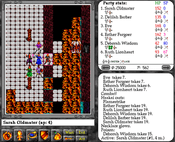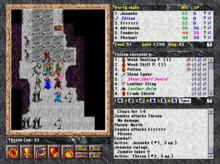Exile (1995 video game series)
Exile is a series of role-playing video games created by Jeff Vogel of Spiderweb Software.[1] They were released as shareware titles for Macintosh and Windows systems. Exile III was also ported to Linux by a third party. There were four games released in the series. All of the games were later revived in the Avernum series. Common to all games in the Exile series are 2D graphics and basic sound. The graphics in the first versions of Exile I and II had simple textures, colours and outlines, which were then replaced in later versions with Exile III's graphics. The games are designed to be non-linear and long in gameplay length.
| Exile | |
|---|---|
| Genre(s) | Role-playing video game |
| Developer(s) | Spiderweb Software |
| Publisher(s) | Fantasoft |
| Creator(s) | Jeff Vogel |
| Platform(s) | Windows, Macintosh, Linux (Exile 3) |
| First release | Exile: Escape from the Pit January 1995 |
| Latest release | Blades of Exile December 1997 |
Gameplay
In each game, the player is required to create six characters to form a party of adventurers or may instead use a default party. The characters' general, combat, magic and miscellaneous skills can be customized along with the character names and graphics. From Exile II onward, characters can have their traits and race configured.
The games have three modes including Outdoor Mode, Town Mode and Combat Mode. In Outdoor Mode, the party can enter a town, engage a group of enemies in Combat Mode and rest (if the party has food). In Town Mode, the party can talk to people, purchase from shops (provided they have enough gold), train the characters (provided they have sufficient gold and skill points), find sub-quests, pick up items (From Exile 2 onward, items can be stolen) and enter Combat Mode. In Combat Mode, the party can attack enemies, defend themselves and pick up adjacent items. Combat Mode can be ended at any time in towns, but can only end outdoors when all enemies are killed.
Magic is divided into Mage and Priest spell types. Spells for attacking can be only be cast in Combat Mode. Some spells, such as Light spells, can be cast at any time. Other spells can only be cast outdoors or in town when not in Combat Mode. Players can create a character equipped with spells up to level 3, but higher level or certain spells must be purchased or found in special encounters.
Games

Exile I: Escape from the Pit
The first game of the Exile trilogy released in January 1995 sees a party of newly created characters thrown from the world above into the subterranean world known as Exile.[2] Once here, the party discovers a civilization formed from the outcasts of the Empire above, a culture beset by constant warfare and monsters galore. The party meets with many of those who wish to get revenge on the Empire for the wrongs it has done to the peoples of Exile.
The characters become a rallying point around which the people of Exile who desire vengeance gather to focus their energies into finding a way to strike back against the cruel Emperor of the surface. Together, the party manages to assassinate Emperor Hawthorne in his throne room, banish the demon king Grah-hoth who was becoming a significant threat to the citizens of Exile, and secure an escape route to the surface..
Exile II: Crystal Souls
The second Exile game follows directly from the first, released in November 1996.[3] The Empire has begun to recognise the threat the Exiles pose and begin sending their army down into Exile in huge numbers. To make matters worse, unknown barriers of energy are sprouting up around the world – sometimes aiding the Exiles, sometimes helping the Empire who can afford the losses much more easily than the Exiles.
A new party of characters meets one of the creatures causing the barriers sprouting up in Exile and go to meet with the unknown race to negotiate. In the end, the party is more successful - and the Vahnatai join with the Exiles to drive out the Empire. With the support of the Vahnatai the Exiles turn the tables on the Empire and successfully repulse their invasion.
Exile III: Ruined World
The final release in the Exile trilogy takes place some time after Exile II, released in January 1997.[4] The Linux version was ported by Boutell.com in Summer, 2000.[5] A lot of preparation has taken place and now the Exiles are ready to send a selected few back into the light of the surface. However, while the members of the expedition are at first stunned by the sheer beauty of the land around them, they begin to notice that things are not as perfect as they seem. The slimes the party encounters are only the first part of what becomes a series of monsters and terrible occurrences that are blighting the Empire and laying it to waste.
While scouting the land, as were the expedition members' orders from the nation of Exile, the members are asked by the Empire to help save the surface from its blight. They bring the Exiles and the Empire together as allies trying to find the cause of the destruction.

Blades of Exile
Blades of Exile released in December 1997, consists of three short scenarios set after the main trilogy as well as an editor that allows players to create their own scenarios, which need not be set in the Exile game world at all.[6] Several hundred custom-made scenarios have been designed since the release of the game in 1997. The most prominent meeting places on the web of the Blades of Exile community are the official company-hosted internet forum. These forums offer support for beginning designers and players, reviews of new scenarios and general discussions about the use of the scenario editor. In June 2007, Jeff Vogel released the source code and game content for Blades of Exile, which is currently under version 2 of the GNU General Public License.[7]
Release
On December 1, 1998, the first three Exile games also came packaged on a CD called the "Exile Trilogy CD".[8] As of July 8, 2013, these games are freeware on Spiderweb Software's website.
Reception
The Exile trilogy was very well received. PC Gamer wrote that Exile: Escape from the Pit "offers an easygoing point-and-click interface; pleasant, if unambitious, graphics; ... literate prose; and a vast scope." Exile II: Crystal Souls won the 1995 Eddy Award Honorable Mention for Best Shareware Game of the Year, and received a 5 out of 5 star rating from ZiffNet. Exile III: Ruined World[9] received the Shareware Game of the Year award from Computer Gaming World and Ziff-Davis Publishing.
Inside Mac Games nominated the first Exile as its pick for the best role-playing game of 1996, but ultimately gave the award to Heroes of Might and Magic: A Strategic Quest.[10]
Exile II was a finalist for MacUser's award for the best shareware game of 1996.
Avernum
More recently the Exile games have been remade as the Avernum series, which replaced the two-dimensional tile-based graphics system with an isometric one and made numerous changes to the RPG system and some changes to the content.[12] Fifth and sixth titles in the series are available under the Avernum moniker and engine.
Engine and Interface
While the game engine itself remained relatively similar between all games in the series, the interface went through many changes. Each iteration sported a new layout and color scheme, as well the individual elements, like the inventory and character roster boxes, were also changed to display information differently. Between Exile I and Exile II the most notable difference is a background color change as well as a change to the border of the play window. Between Exile II and Exile III the interface was changed significantly in that the colors and window styles were changed again but the player roster was overhauled and an inventory window was added. The changes between Exile III and Blades of Exile were more subtle and were again of the color and style nature.
See also
- List of open source games
References
- "About Us".
- "Exile: Escape From the Pit v2.0 for Windows".
- "Exile II: Crystal Souls 2.0.1 for Windows".
- "Exile III: Ruined World for Windows v1.0".
- "Exile III: Ruined World for Linux".
- "Blades of Exile".
- Blades of Exile Source Code
- http://www.metacritic.com/game/pc/exile-trilogy-cd
- "Archived copy". Archived from the original on 2011-06-15. Retrieved 2010-05-27.CS1 maint: archived copy as title (link) Accessed: May 27, 2010
- IMG Staff (1997). "1996 Games of the Year". Inside Mac Games. 5 (2). Archived from the original on February 18, 1998. Retrieved August 14, 2019.
- "Our Games".
External links
- Spiderweb Software
- Blades of Exile Source Code
- Encyclopedia Ermariana - an extensive encyclopedia of Exile
- Exile series at MobyGames